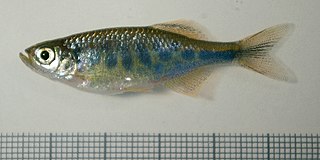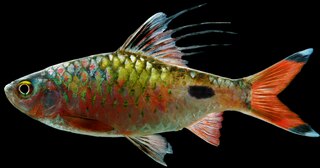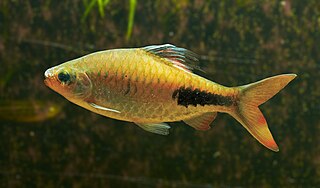
Barbus is a genus of ray-finned fish in the family Cyprinidae. The type species of Barbus is the common barbel, first described as Cyprinus barbus and now named Barbus barbus. Barbus is the namesake genus of the subfamily Barbinae, but given their relationships, that taxon is better included in the Cyprininae at least for the largest part.

Puntius is a genus of small freshwater fish in the family Cyprinidae native to South Asia and Mainland Southeast Asia, as well as Taiwan.

Devario is a genus of fish in the family Cyprinidae native to the rivers and streams of South and Southeast Asia. These fishes have short barbels and many species having vertical or horizontal stripes. These species consume various small, aquatic insects, crustaceans and worms, as well as, in the case of fry, plankton.

Rasbora is a genus of fish in the family Cyprinidae. They are native to freshwater habitats in South and Southeast Asia, as well as southeast China. A single species, R. gerlachi, is only known from an old specimen that reputedly originated from Africa (Cameroon), but this locality is considered doubtful. They are small, up to 17 cm (6.7 in) long, although most species do not surpass 10 cm (4 in) and many have a dark horizontal stripe.

Barbonymus is a ray-finned fish genus in the family Cyprinidae, containing some barb species. The genus was only established in 1999, with the tinfoil barb as type species; thus, these fish are sometimes collectively called tinfoils. The new genus was established in recognition of the fact that some large Asian "barbs", formerly rather indiscriminately lumped in Barbus, Barbodes and Puntius, form a distinct evolutionary lineage.

Labeo is a genus of carps in the family Cyprinidae. They are found in freshwater habitats in the tropics and subtropics of Africa and Asia.

Barbodes is a genus of small to medium-sized cyprinid fish native to tropical Asia. The majority of the species are from Southeast Asia. Many species are threatened and some from the Philippines are already extinct. A survey carried out in 1992 only found three of the endemic Barbodes species, and only two were found in 2008. Several members of this genus were formerly included in Puntius.

Mystus is a genus of fish in the family Bagridae native to Asia. Phylogenetic relationships within this genus are poorly understood, though it has been suggested that there are two major lineages.

Neolissochilus is a genus of fish in the family Cyprinidae native to freshwater habitats in Asia that are often grouped with the mahseers. The largest reach up to 1.2 m (3.9 ft) in length, but most species are much smaller.

Dawkinsia filamentosa, the filament barb, or poovali paral is a species of barb. Young fish have barely any color and black spots. They start having more color at three months old. The fish is a swift swimmer. Males are larger than females and they fertilize eggs by swimming into the cloud of eggs. The species is most commonly found in coastal floodplains near the Southwest Indian states of Kerala, Tamil Nadu and Karnataka. This species is also known as blackspot barb.

Dawkinsia assimilis is a species of ray-finned fish in the genus Dawkinsia. It is endemic to the southern Western Ghats especially to the Southwest Indian states of Karnataka and Kerala. They are known as Mascara Barb. Filament barbs are a group of small freshwater fishes found in the rivers of peninsular India and Sri Lanka. There are nine species known under the genus Dawkinsia. These barbs are popular among aquarium hobbyists as an ornamental fish and are also collected from rivers and bred for trade.

Cyclocheilichthys is a genus of ray-finned fish in the family Cyprinidae containing approximately nine valid species. They are native to freshwater habitats in Southeast Asia and China.

Hypselobarbus is a genus of fish in the family Cyprinidae endemic to India.

Opsarius is a genus of fish. Its representatives can be found in a variety of countries in South East Asia. These countries include Cambodia, Laos, Thailand, Myanmar, India, and China. Certain species of Opsarius are considered endemic to their respective habitats; such as Opsarius cocsa and Opsarius maculatus which are endemic to India.

Osteochilus is a genus of freshwater ray-finned fish belonging to the family Cyprinidae, the family which includes the carps, barbs, minnows and related fishes. The fishes in this genus are mainly found in Southeast Asia with a few extending into adjacent parts of China.

Dawkinsia is a genus of cyprinid fishes from freshwater in South India and Sri Lanka. It was split off from genus Puntius in 2012.

Pethia is a genus of small freshwater fish in the family Cyprinidae native to South Asia, East Asia and Mainland Southeast Asia. Some species are commonly seen in the aquarium trade. The name Pethia is derived from the Sinhalese "pethia", a generic word used to describe any of several small species of cyprinid fishes. Most members of this genus were included in Puntius, until it was revised in 2012.

Laubuka is a genus of cyprinid fish found in South and Southeast Asia.
Smiliogastrinae is a subfamily of freshwater ray-finned fishes belonging to the famly Cyprinidae, the family which includes the carps, barbs and relalted fishes. The fishes in this genus are found in Africa and Asia and are commonly referred to as barbs.
Plamoottil, M. & Maji, D, (2020) Systomus gracilus: a new fish (Cypriniformes: Cyprinidae) species from West Bengal. Journal of Experimental Zoology, India. 23 (2): 1033- 1038.


















